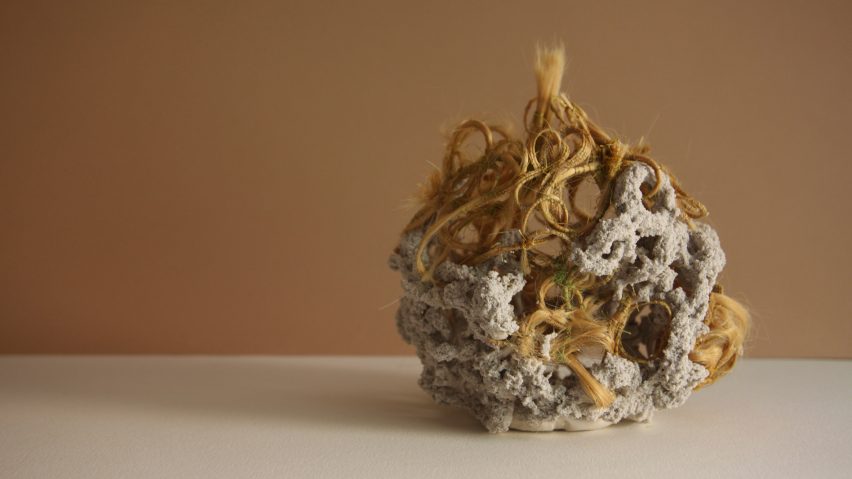Artist Anouska Samms created pots from clay and donated human hair to playfully explore her family's matrilineal relationship, which were recently on show as part of an exhibition in London.
Called This Myth We Make, the exhibition by Samms included a collection of pots displayed on rugged wood and plaster plinths as well as an accompanying film and a large hanging tapestry.
The various pots are formed from lopsided shapes made out of coloured clay but are defined by the many strands of human hair that decorate them.
Samms received the hair from a range of strangers from around the world including Mexico, Australia and Japan after inviting volunteers to offer up their hair through a call-out on her Instagram.
This was achieved during national lockdowns when people were cutting their hair at home as they could not access salons, according to the artist.
"The combination of hair and clay and the different varieties of each that are used merge in an unusual way," she told Dezeen.
"This subverts the more traditional pots – particularly the hand-thrown ones – into what I think of as unstable vessels or dysfunctional containers. Using hair is also just a bit cheeky at times," she added.
As well as hair from strangers, Samms used hair donated by her mother and grandmother, which she explained links to the meaning behind her work.
This Myth We Make intends to playfully explore the matrilineal relationship between five generations of women in Samms' family who all dyed their hair red as an intimate family tradition.
As a natural redhead herself, the artist described how she poetically continues the tradition without needing to dye her hair.
"This body of work reflects a deeper unconscious – I would even call it an obsessive illustration of matrilineal connection – and the familial 'myths' we consciously or unconsciously adopt to communicate our love for others," said Samms.
In line with this theme, the artist bleached and dyed the donated hair different shades of auburn, which was also used to form Big Mother – a large tapestry presented in the exhibition.
Her design process involved tying the hair into bunches before it was coloured, after which she washed it in her own bathtub and eventually sewed or shaped it onto pots or into the tapestry.
"Sometimes just preparing the hair alone took a couple of days," reflected Samms.
While the artist chose to incorporate hair into her pots in reference to her family's unique tradition, she explained how she crafted the vessels from clay due to the material's similar malleability and organicness.
"There is also potential for disgust and bodily horror in the use of disembodied human hair – another humorous nod at the purity and absurdity of mother and daughter exchange," concluded Samms.
The exhibition was curated by the V&A museum's curator of digital design Natalie Kane while the show's technical producer Greg Bradlaugh created the plinths from abandoned wood that he found and covered in white plaster.
Other designs that are made from human hair include a textile by research studio Pareid that was created to measure urban pollution and a biodegradable stool by Oksana Bondar called Wiggly.
The photography is by Benjamin Swanson.
This Myth We Make took place at SET Studios in Lewisham, London, from 20 May to 1 June 2022. See Dezeen Events Guide for an up-to-date list of architecture and design events taking place around the world.
Project credits:
Artist: Anouska Samms
Curator: Natalie Kane
Technical Producer: Greg Bradlaugh

